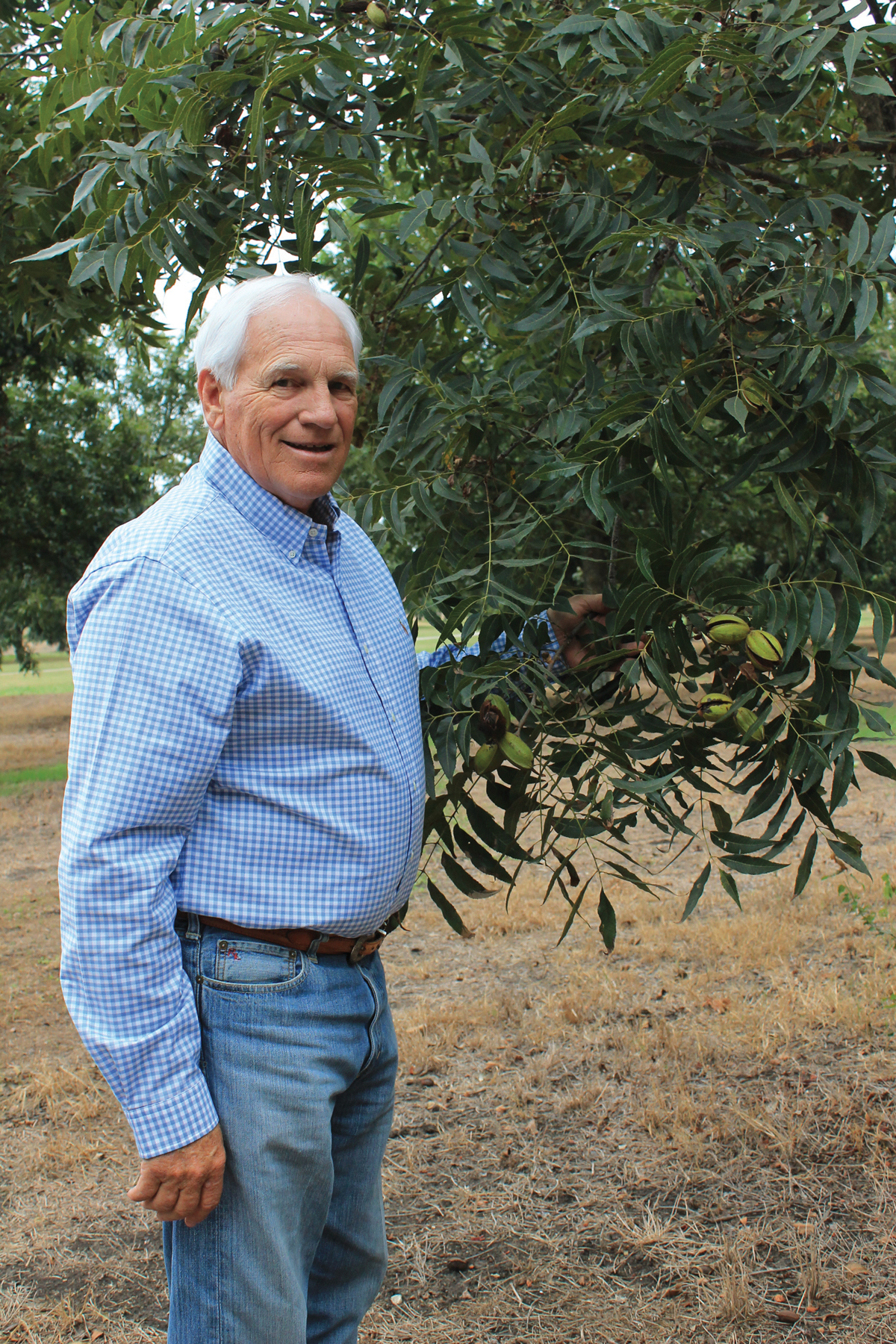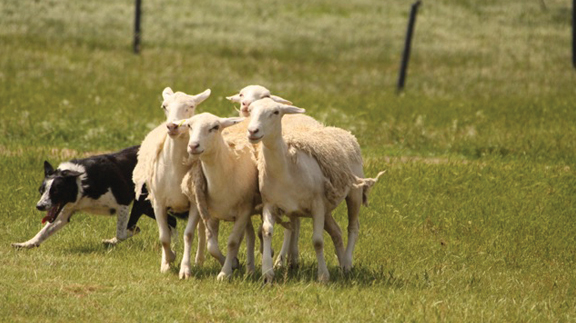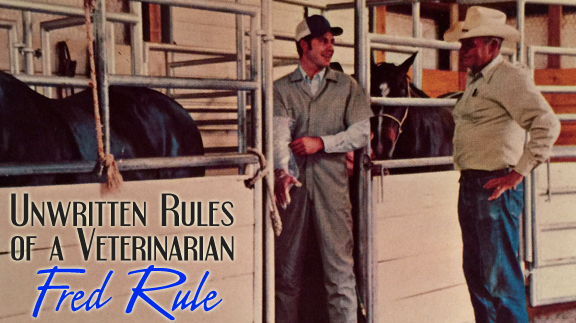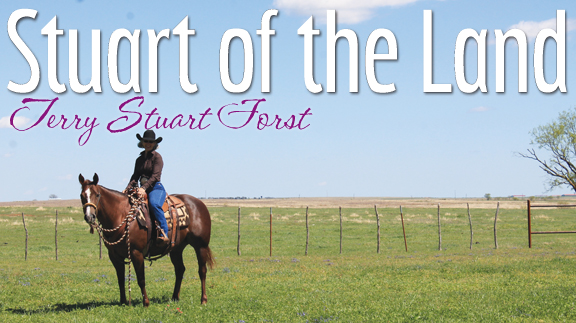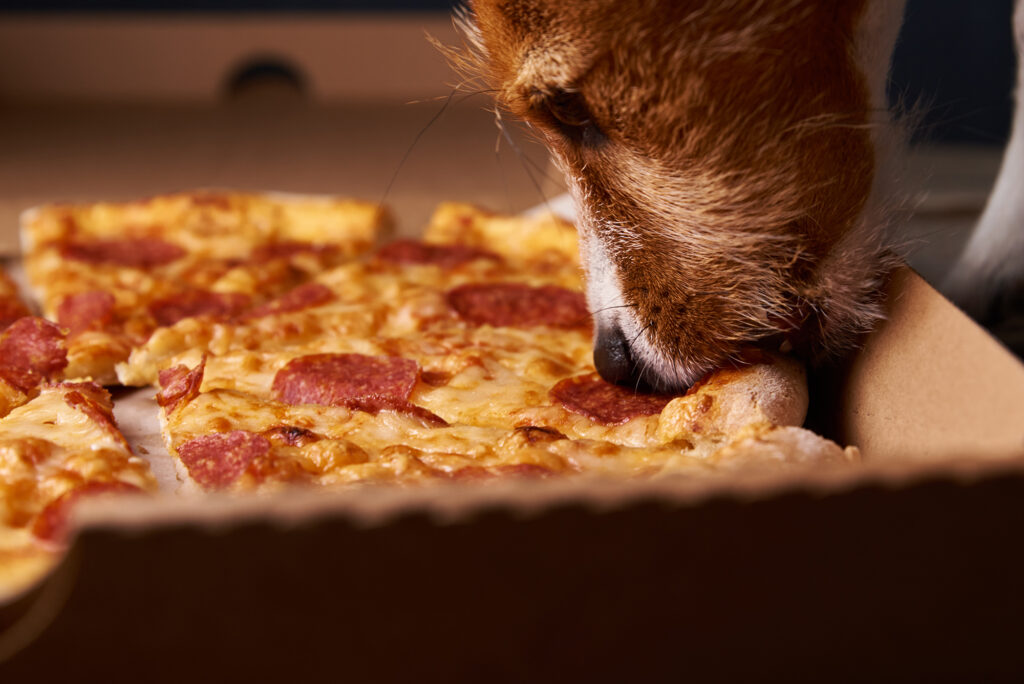Country Lifestyle
November 2017 Profile: Scott Landgraf
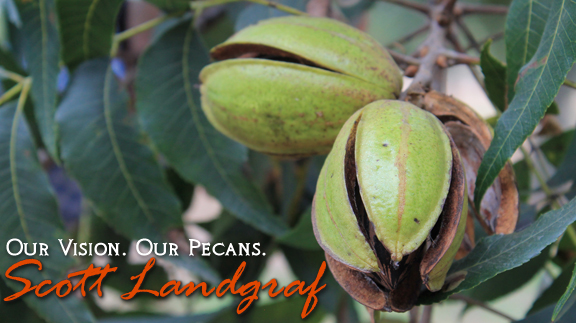
Our Vision. Our Pecans.
By Laci Jones
On a cloudy, late September morning in Madill, Okla., Scott Landgraf picked a pecan off the ground and pulled out a small pocket knife. The owner of Landgraf Farms began carving away the shell, leaving two pecan halves. Once he finished splitting the pecan, he looked up and said, “This is a lost art.”
Oklahoma produces an average of 20 million pecans each year, Landgraf explained. This year, Oklahoma is predicted to harvest 30 million pounds of pecans.
“The largest crop that’s been reported in history is 60 million from Oklahoma,” he added. “I don’t know how this crop is going to come out, but it may be more than 30 million this year. It’s really a pretty good crop.”
Born in 1948, Landgraf saw firsthand the advancements in pecan harvesting, sanitization and shipping. Growing up, his father Bill Landgraf harvested native pecan trees that grew along the creeks.
“My interest in pecans stemmed from the first real money I ever made by picking pecans up out of the water in the creek,” Landgraf recalled. “It was very hard work, but I look back on it as favorable memories.”
The father-son duo climbed many native pecan trees and used cane poles to flail the pecans. The pecans that landed on the bank were his dad’s, and Landgraf claimed the pecans that he could clean out of the creek, he added.
“My family saw pecans as an opportunistic crop,” Landgraf said of his parents. “It was not a crop per se. It was just something that enabled them to have extra things for what we think as today as just bare necessities.”
In the early to mid- ‘60s, Bill began seeing pecans as orchards. He cleared bottomland and started grafting the pecan trees to varieties available—Stuart and Mahan. Bill later began experimenting with different pecan varieties in the ‘70s. While some pecan varieties fared better than others, Bill had a successful harvest. His wife Leota took the first step in marketing Landgraf Farms by selling pecans out of their carport.
Meanwhile, Scott Landgraf attended Murray State College in Tishomingo, Okla., where he met his wife Janice. A year behind Landgraf in college, she followed the Madill, Okla., native to Oklahoma State University, where she received a bachelor’s degree in education. They married in 1971.
While pursuing a master’s degree in agronomy from OSU, Landgraf began working for the Noble Foundation. Landgraf obtained his master’s degree in 1973 and began his career spanning 30 years with the foundation now known as the Noble Research Institute. Landgraf first worked as a manager of their soil and forage testing laboratory. As time progressed, the manager became an agricultural consultant.

Landgraf Farms plant a variety of pecans on their farm in Madill, Okla., including the Pawnee variety. (Photo by Laci Jones)
“As time went on, they recognized my interest in pecans,” Landgraf explained. “I continued to do a lot of work in water and nutrition associated with pecan production and towards the end of my tenure with the Noble Foundation, I was their pecan specialist. My years at Noble have provided me an amazing education into the process of growing pecans.”
At 55 years old, the pecan specialist retired from the Noble Foundation to focus on the family farm. He started his pecan orchard in 1976, planting 250 pecan trees out of sight.
“I planted them back where nobody could see them because I didn’t know if it was going to work or not,” Landgraf laughed. “I was afraid of everyone seeing my failure.”
The planting was successful with only about three trees dying that season. Landgraf said the first season proved the pecan business takes labor and commitment. From planting to harvest, pecan production became a family endeavor.
“In fact, we had a baby at the time, and we set a playpen in the middle of planting trees,” Landgraf recalled. “We basically planted trees around the baby.”
That commitment was tested in June 1996 when a thunderstorm uprooted nearly every native pecan tree to the east of the farm. While orchards were also located on the west side of the farm, Landgraf said the storm demolished one of their main sources of income and involvement in pecans.
“It was a matter of just pushing them up in a pile and burning them,” he added. “There was no recovery.”
The setback resulted in a family meeting to discuss the future of Landgraf Farms.
“I remember very vividly setting the family around the table to say, “Hey, are we going to go ahead and rebuild this or are we going to just stay at this size?” he recalled.
It was a unanimous decision among the Landgraf family to rebuild the orchard. They cleaned up all the debris from the storm, drilled wells and installed irrigation lines. With a large tree spade, they moved half of the trees on the west side of the farm to the east.
Many people commented on the project, thinking the Landgraf’s were building a large barn.
“When I got ready to transplant the trees, I cut all side limbs off and painted the trunks white,” Landgraf explained. “When they looked up here, it did look like the start of a barn with just a pole sticking up.”
The project could be viewed from the Landgraf’s back window. His wife Janice said the trees looked like a cemetery with the trees resembling tombstones. She asked Landgraf if it will ever look like a pecan orchard, he recalled with a laugh.
Today, the pecan orchard no longer looks like a cemetery but like a pecan orchard, but each year takes the same commitment and hard labor as the first year. Each January and February, the Landgrafs plant 10 to 15 acres of new orchards, which entails installing main water lines, irrigation systems and well development.
Buds start to break by the first of April, and Landgraf applies zinc and nitrogen to the developing leaves.
“I might put on an insecticide, but I think that the zinc and nitrogen spray is just really important to the development and the health of the tree,” he added.
During the dormant season, he monitors for common diseases and pests that can be detrimental to the health and development of the pecan trees including pecan scab and pecan nut case bearer.
The shucks on the pecans start to split by the end of September. Because the pecans are not harvested until October and November, the pecans are vulnerable to freeze.
“There’s still that existing threat,” Landgraf explained. “As soon as the shuck splits, the shucks start to dry down and the nut is physiologically mature, we’ll start harvest.”
Landgraf harvests 160 acres on the farm, 100 acres on his father’s leased land and 500 acres of native pecan trees on leased land. He also currently has almost 100 acres of pecan trees planted that are not in production. The Landgrafs plant different varieties of pecans including Kanza, Caddo, Choctaw and Pawnee.
The Choctaw variety is their No. 1 big nut, Landgraf said. The desirables are big nuts, but they are disease-prone. Producers who choose to plant the Choctaw variety need to increase their “level of management” because the Choctaw variety requires plenty of water and nutrients to resist these diseases, he added.
The Kanza variety is a high quality pecan, but it is a small nut. The Caddo variety is similar to the Kanza variety in size, but it is more susceptible to diseases like scab. It is a high-quality nut and the most consistent yielder.
Landgraf found consumers will not purchase the small pecan varieties like Kanza and Caddo in the shell because it is smaller than other varieties. However, consumers prefer the smaller nuts that are high-quality when the shells are removed.
“In all of agriculture, I think we have to conform our production practices to meet the demand of the consumer,” Landgraf explained. “In our retail shop, we certainly abide by that rule and cater to them.”
The Pawnee variety matures first, and the Landgrafs begin harvesting this variety by mid-October. The nuts are taken to the shop where they are cleaned, sanitized and dried.
“It is kind of an arrangement with my wife and me that I get them to the shop, and she takes them and sells them,” he added.
His wife Janice uses social media along with drive-by traffic to sell their entire crop in the farm’s retail shop. The retail shop is open November and December each year, selling a variety of products including chocolate covered pecans and pecan oil. As soon as all sales are completed, Landgraf begins fertilizing and cleaning up any brush left over from harvest.
With more than 30 years of experience in pecan production, Landgraf said there are three keys to have a successful pecan orchard—water, micro-organisms and nutrition. Making sure the pecan trees have an adequate supply of water is the most important key. Landgraf Farms implemented an irrigation system to combat the common Oklahoma drought.
“Along with that, I make sure that I’ve got adequate water supply and all my irrigation comes from wells,” he added. “I’ve been blessed with a major aquifer under the farm that I was not aware of. It’s just a real blessing.”
The second and third keys to encouraging healthy pecans are proper nutrition and micro-organisms. The Landgrafs apply pesticides to overcome threatening pests. It is imperative for producers to understand the life cycles of insects and diseases to properly manage the orchard.
“I only use pesticides when I have to have them,” he added. “I’m not saying I’m against use of pesticides. It’s just I use them sparingly, and my greatest friends are the beneficial insects and all the micro-life in the soil.”
Landgraf said technology made a positive impact on this growing industry.
“It went from using a cane pole to get them out of the tree to not knowing where you go to buy a cane pole,” he added. “It’s been in my lifetime, and we take it for granted.”
The pecan shelling plants had large structures with different devices when Landgraf was young. He said there was a divide in the industry from the growers, the shellers and the sellers. Landgraf’s father approached Basil Savage of Savage Equipment after attending a pecan shaker demonstration in Madill, Okla.
He convinced Savage to construct the first pecan shaker in his machine shop in Ardmore, Okla. Savage built and sold him that pecan shaker to use on the large native trees at the farm. The machine was not big enough to shake the trees well, so they had to shake them several times.
“I mean it was cool to use a tractor to get those nuts out instead of having to crawl around like a squirrel,” Landgraf recalled. “That process continued on. I can harvest the 160 acres on this place in less than a week with myself and a couple hands. It’s just phenomenal.”
As for the future of Landgraf Farms, he said he hopes to continue the vision of expansion with his family. He and his wife Janice have three sons—Jeff, Wes and Justin, and four granddaughters.
The retail shop is located at 18814 Highway 70, Madill, OK 73446. For addition information on Landgraf Farms, visit www.LandgrafFarms.com.
This article originally appeared in the November 2017 issue of Oklahoma Farm & Ranch.
Country Lifestyle
Riding for the Brand
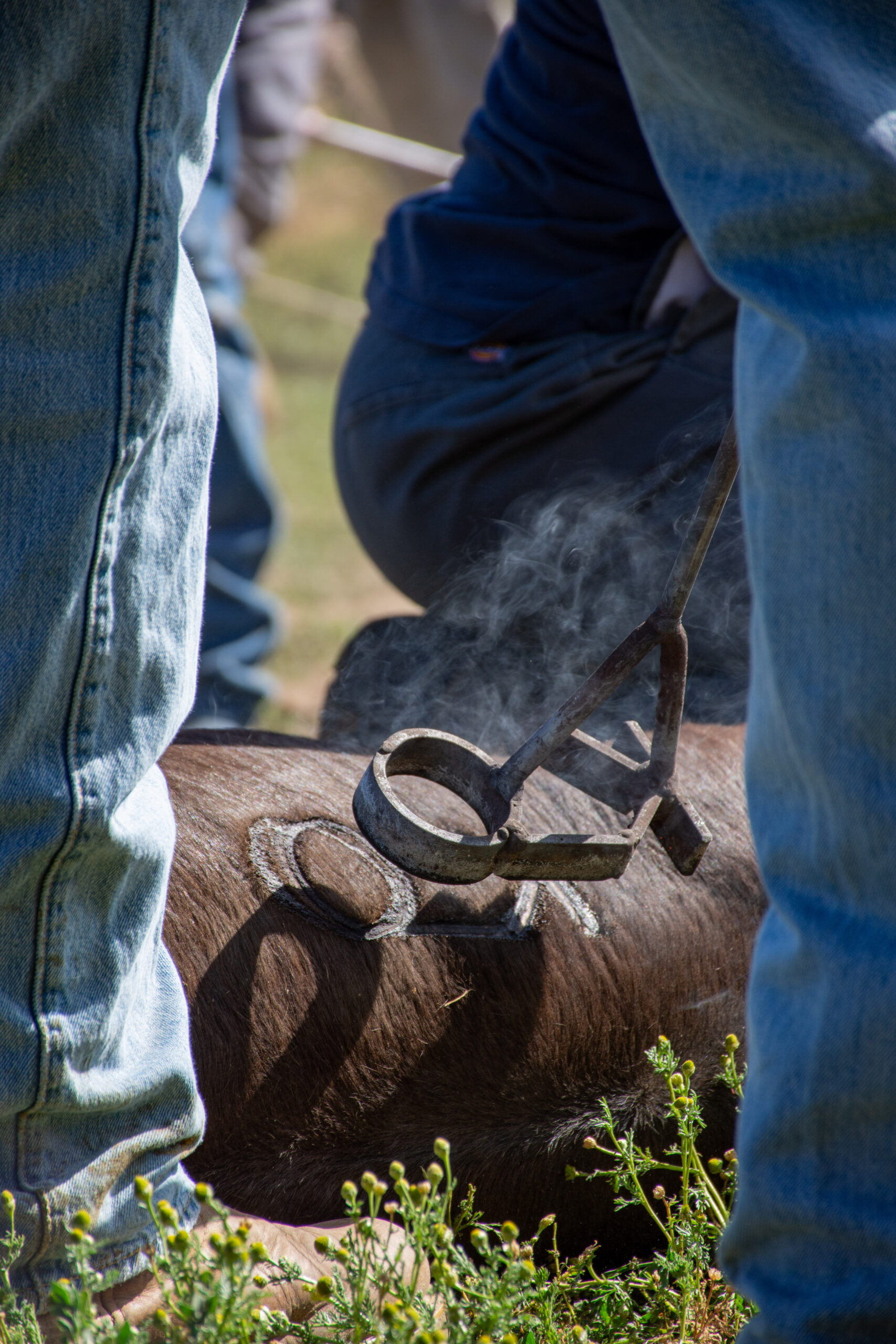
By: Christopher Dysinger
According to the Code of the West a man who has integrity is one who rides for the brand. If you are unfamiliar with cowboy parlance this phrase is used to describe being loyal to the outfit you work for. Cowboys were, “intensely loyal to the outfit they were working for and would fight to the death for it. They would follow their wagon boss through hell and never complain.” -Teddy Blue Abbot. Riding for the brand means being loyal and when I consider what it means to be loyal I am reminded of the words of the Lord Jesus to His disciples in Matthew 16:24, “Then said Jesus unto His disciples, If any man will come after Me, let him deny himself, and take up his cross and follow Me.” To me, to take up the cross and follow the Lord is the epitome of what it means to ride for the brand.
When you place your trust in the Lord Jesus you are signing on to His outfit, to speak the language of the West. When you called upon the name of the Lord Jesus by faith, He saved you and from this point you are riding for His brand. In taking up your cross and following Him you have pledged to be loyal, and this means you face any hardship or trial like a cowboy on the trail moving the herd. Any complaint must be swallowed in the same way you would swallow a cup of coffee. When I hear our faith and loyalty to the Lord Jesus put into these terms it stirs something within me that moves me to keep right on riding for the brand.
Louis L’amour wrote, “Riding for the brand was an expression of loyalty to a man’s employer or the particular outfit he rode for. It was considered a compliment of the highest order in an almost feudal society. If a man didn’t like a ranch or the way they conducted their affairs he was free to quit, and many did; but if he stayed, he gave loyalty and expected it. A man was rarely judged by his past only by his actions. Many a man who came west left things behind him he would rather forget, so it was not the custom to ask questions. Much was forgiven if a man had courage and integrity and if he did his job. If a man gave less than his best, somebody always had to pick up the slack, and he was not admired.” It is the same when a person gives his or her heart to Jesus.
When you come to the Lord Jesus you are not judged by your past. When you come to the Lord Jesus, repenting of sin and seeking forgiveness, everything from your past is left behind. All will be forgiven. 1 John 1:9 reads, “If we confess our sins, He is faithful and just to forgive us our sins, and to cleanse us from all unrighteousness.” When you place your faith in the Lord Jesus you are promising to be loyal and in return you will receive the same. He has promised that He will never leave us or forsake us. When you walk with the Lord Jesus through life you are indeed, “riding for the brand.”
“Riding for the brand” is not just an expression of loyalty nor is it just an expression of pride, it is also an expression of love. When a cowboy claims to be riding for the brand, he is telling any other outfit who may seek his loyalty, that he cannot give it, because he has given his word to another. It is the same when we pledge our faith and loyalty to the Lord Jesus. If any would call us away from Christ we cannot go, because we are riding for the brand.
The End
This article is an excerpt from the book, The Bible and the Code of the West by Dr. Christopher Dysinger.
Country Lifestyle
Farm Dogs & Table Scraps
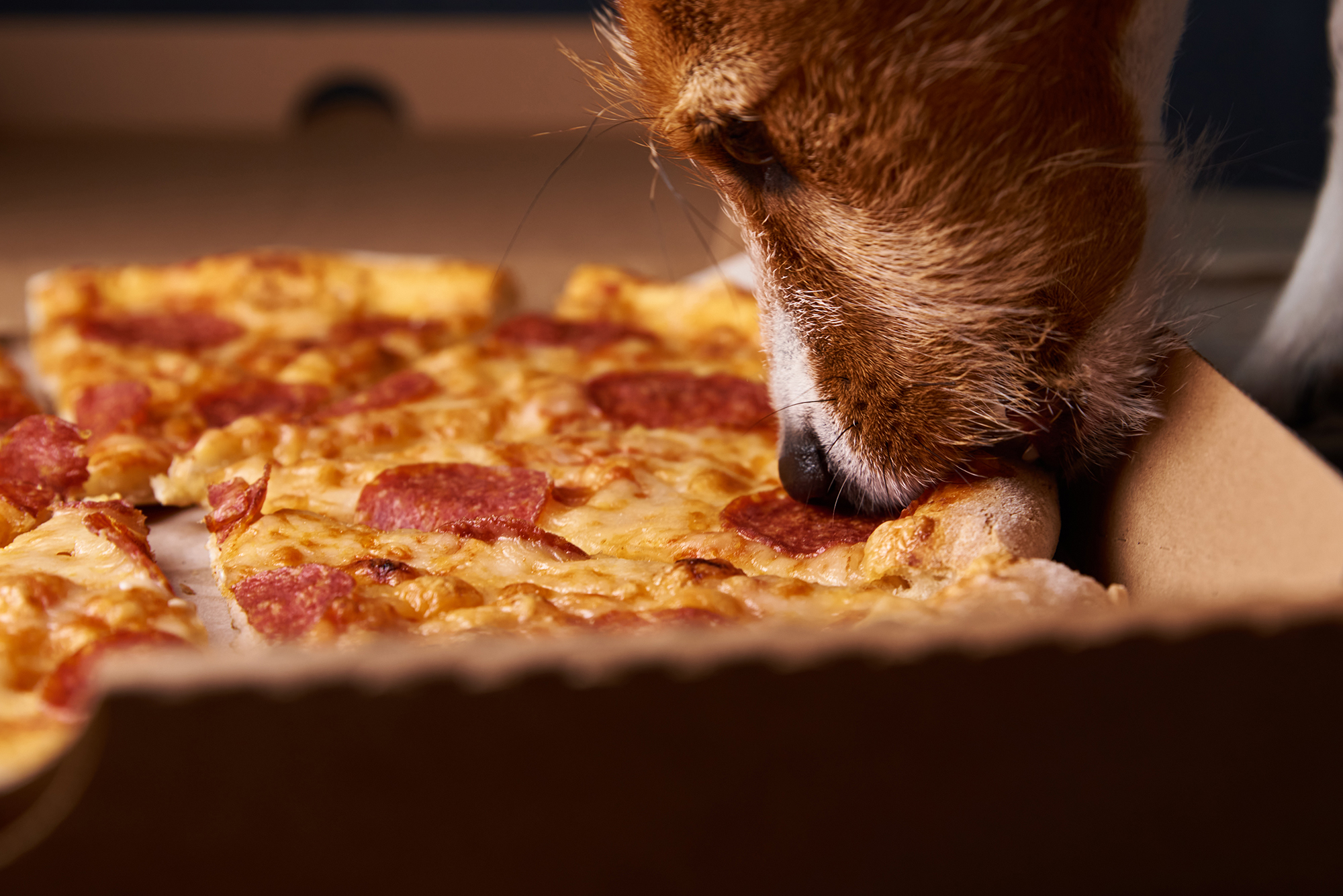
What’s Safe and What’s Not?
Growing up on a farm, our dogs were tough. They roamed the pastures, slept under the barn, and ate just about anything they could get their paws on—whether we meant for them to or not. I’ll admit, I never thought twice when one of our old cow dogs snatched a biscuit off the table or licked up a spill from the barn floor. I’ve even seen a dog steal a whole rib bone off a plate and trot off like he’d won the lottery. And somehow, they always seemed fine.
But here’s the thing—just because they survived doesn’t mean it was safe. For every farm dog that lucked out, there’s another that wasn’t so fortunate. Some human foods can be downright toxic to dogs, and a little bit of bad luck (or a smaller, more sensitive dog) can turn a harmless snack into an emergency.
Common toxic foods lying around the farmhouse
If you’ve got a farm dog—or any dog, really—you need to be aware of the dangers lurking in everyday foods. Some of the biggest culprits include:
Chocolate – The darker it is, the worse it is. Even a little can cause vomiting, seizures, or worse.
Grapes & Raisins – No one’s exactly sure why, but they can cause kidney failure fast.
Onions & Garlic – In large enough amounts, these can destroy red blood cells, leading to anemia.
Xylitol (Found in Sugar-Free Gum & Candy) – This artificial sweetener can send a dog’s blood sugar crashing and cause liver failure.
Alcohol – Even small amounts can be deadly to dogs, affecting their nervous system much more than it does ours.
Bones from Cooked Meat – While not necessarily toxic, they can splinter and cause serious internal injuries.
Macadamia Nuts – These can lead to weakness, vomiting, and even paralysis in dogs.
What to do if your dog eats something toxic
First, don’t panic—but don’t ignore it either. If you know your dog ate something dangerous, call your vet immediately. They can tell you whether to induce vomiting or if it’s something that requires urgent care. If it’s after hours, contact the ASPCA Animal Poison Control Center (888-426-4435) or the Pet Poison Helpline (855-764-7661).
Prevention is always the best medicine, so keep toxic foods out of reach. That might mean keeping the trash can secured, making sure kids don’t slip the dog a treat under the table, or just being more mindful of what’s left on the counter.
Our farm dogs might have been lucky, but luck isn’t a great strategy when it comes to their health. A little awareness goes a long way in making sure they stay happy, healthy, and ready for the next day’s work.
For more information
ASPCA Animal Poison Control: www.aspca.org/pet-care/animal-poison-control
Pet Poison Helpline: www.petpoisonhelpline.com
Visit www.akc.org/expert-advice/nutrition/foods-your-dog-should-never-eat
Country Lifestyle
Summer Squash and Corn Chowder

By Lacey Vilhauer
Total time: 40 minutes
Servings: 6-7
Ingredients
- 6 slices bacon, cooked and crumbled and 1 1/2 Tbsp rendered bacon fat reserved
- 1 1/2 lbs yellow squash, chopped (about 3 medium)
- 2/3 cup thinly sliced celery
- 1 cup diced onion
- 1 Tbsp flour
- 2 cloves garlic, minced
- 2 3/4 cup milk (I used 1%)
- 5 cups canned or fresh cut corn (from about 6 ears corn), divided
- 1/2 cup heavy cream
- 1 1/2 tsp chopped fresh thyme (or 1/2 tsp dried)
- 3/4 tsp salt, then more to taste
- 1/4 tsp freshly ground black pepper, then more to taste if desired
- 3/4 cup shredded cheddar cheese, for serving
- Chopped green onion for garnish (optional)
Instructions
Heat 4 tsp reserved bacon fat in a large pot over medium-high heat. Add celery and onion and sauté 2 minutes then add the squash.
Saute until tender, about 6 minutes, adding in garlic and flour during last 2 minutes of sauteing. Reduce heat slightly.
Add 1 1/2 cups milk, 2 cups of the corn, thyme, salt and pepper to the sauteed veggies.
To a blender add remaining 3 cups of corn, remaining 1 1/4 cups milk and the cream. Process in blender until nearly smooth (about 30 seconds).
Add pureed mixture to pot and stir to blend. Cook until mixture reaches a light boil.
Serve warm with shredded cheese, crumbled bacon and sliced green onions if desired.
-

 Attractions8 years ago
Attractions8 years ago48 Hours in Atoka Remembered
-

 Country Lifestyle9 months ago
Country Lifestyle9 months agoJuly 2017 Profile: J.W. Hart
-

 Country Lifestyle9 years ago
Country Lifestyle9 years agoThe House a Treasure Built
-

 Country Lifestyle4 years ago
Country Lifestyle4 years agoThe Two Sides of Colten Jesse
-

 Outdoors7 years ago
Outdoors7 years agoGrazing Oklahoma: Honey Locust
-

 Equine8 years ago
Equine8 years agoUmbilical Hernia
-

 Outdoors5 years ago
Outdoors5 years agoPecan Production Information: Online Resources for Growers
-

 Farm & Ranch7 years ago
Farm & Ranch7 years agoHackberry (Celtis spp.)

